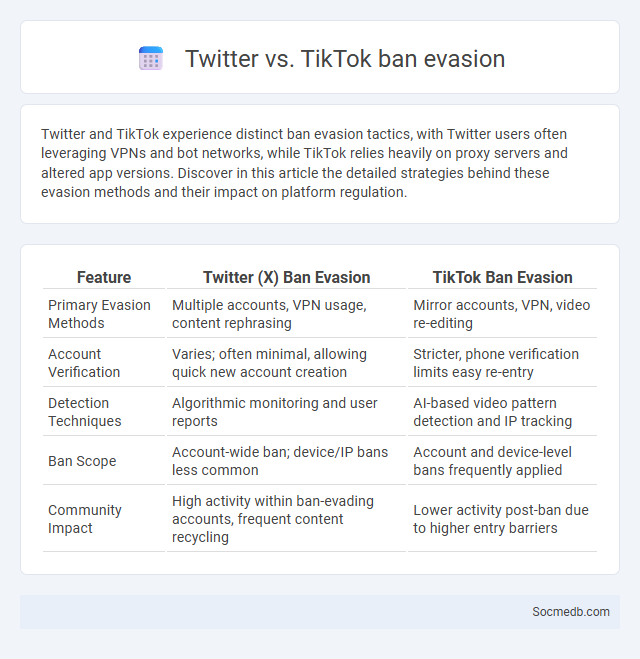
Photo illustration: Twitter vs TikTok ban evasion
Twitter and TikTok experience distinct ban evasion tactics, with Twitter users often leveraging VPNs and bot networks, while TikTok relies heavily on proxy servers and altered app versions. Discover in this article the detailed strategies behind these evasion methods and their impact on platform regulation.
Table of Comparison
| Feature | Twitter (X) Ban Evasion | TikTok Ban Evasion |
|---|---|---|
| Primary Evasion Methods | Multiple accounts, VPN usage, content rephrasing | Mirror accounts, VPN, video re-editing |
| Account Verification | Varies; often minimal, allowing quick new account creation | Stricter, phone verification limits easy re-entry |
| Detection Techniques | Algorithmic monitoring and user reports | AI-based video pattern detection and IP tracking |
| Ban Scope | Account-wide ban; device/IP bans less common | Account and device-level bans frequently applied |
| Community Impact | High activity within ban-evading accounts, frequent content recycling | Lower activity post-ban due to higher entry barriers |
Understanding Ban Evasion: Definition and Context
Ban evasion on social media refers to users circumventing platform-imposed restrictions or bans by creating new accounts or using false identities. This practice undermines community guidelines and can lead to repeated violations of content policies on platforms like Facebook, Twitter, and Instagram. Detecting ban evasion requires advanced algorithms and user behavior analysis to maintain platform integrity and enforce rules effectively.
Twitter’s Ban Evasion Tactics: Methods and Trends
Twitter's ban evasion tactics frequently involve creating multiple fake accounts, using VPNs to mask IP addresses, and employing automated bots to amplify banned users' messages. Recent trends highlight sophisticated networks of coordinated accounts that mimic genuine user behavior to avoid detection by Twitter's algorithms. The platform continuously upgrades its enforcement mechanisms, yet evolving evasion methods challenge effective moderation and platform integrity.
TikTok and Ban Evasion: Common Strategies
TikTok has become a dominant platform for short-form video content, attracting millions of users worldwide. Common ban evasion strategies include creating new accounts with different phone numbers or emails, using VPNs to mask location, and altering user behavior to avoid detection algorithms. To protect your presence, understanding these tactics helps in maintaining compliance and safeguarding your TikTok community.
Comparing Ban Evasion on Twitter vs TikTok
Ban evasion on Twitter often involves users creating multiple accounts or using VPNs to bypass restrictions, exploiting the platform's relatively open API and less stringent identity verification processes. In contrast, TikTok employs more aggressive detection algorithms that analyze user behavior and device fingerprints, making ban evasion more challenging, although some users still succeed by frequently changing devices or manipulating proxies. Studies show Twitter's ban evasion rate is higher due to its older, more established infrastructure and broader user base, whereas TikTok's newer, AI-driven moderation system results in quicker identification and removal of evading accounts.
Detection Technologies: How Platforms Identify Ban Evasion
Social media platforms employ advanced detection technologies such as machine learning algorithms and IP address tracking to identify ban evasion effectively. These systems analyze behavioral patterns, account metadata, and posting habits to flag suspicious activities that suggest attempts to bypass bans. Your ability to maintain a safe and compliant online environment relies heavily on these robust detection mechanisms.
Legal Implications of Online Ban Evasion
Social media platforms enforce bans to maintain community guidelines, but evading these restrictions can lead to serious legal consequences for users. Your attempts to bypass online bans may result in account termination, legal action for violating platform terms of service, or potential charges under cybercrime laws. Understanding the legal risks of online ban evasion helps ensure compliance and protects your digital presence.
Impact of Ban Evasion on Platform Communities
Ban evasion undermines the integrity of platform communities by allowing banned users to bypass restrictions and disrupt conversations, leading to toxic environments that deter genuine engagement. These evaders often manipulate content algorithms, skewing visibility and impairing trust among users. Your experience on social media platforms can be negatively affected as ban evasion diminishes the quality of discourse and hinders community moderation efforts.
Platform Responses: Policies and Enforcement
Social media platforms implement comprehensive policies to regulate content, focusing on harmful behavior such as hate speech, misinformation, and harassment. Enforcement mechanisms include algorithmic detection, user reporting systems, and content moderation teams working to maintain safe digital environments. Your engagement with these platforms involves adherence to community guidelines designed to protect users and foster respectful online interactions.
Notable Cases of Ban Evasion on Twitter and TikTok
Notable cases of ban evasion on Twitter and TikTok involve influential figures who circumvent account suspensions using alternate profiles or VPN services to elude platform restrictions. Platforms employ advanced AI detection and user reporting systems to identify patterns of ban evasion, enhancing enforcement effectiveness. Your awareness of these tactics helps maintain community integrity by supporting swift identification and reporting of such activities.
Future Challenges in Combating Ban Evasion
Social media platforms face escalating challenges in combating ban evasion as users increasingly exploit sophisticated tools like VPNs, proxy servers, and AI-driven identity manipulation to bypass restrictions. Advanced machine learning algorithms and behavioral analytics become essential for detecting subtle patterns indicative of ban evasion, yet privacy concerns and evolving evasion tactics pose continual obstacles. Your online safety depends on platforms' ability to innovate and implement dynamic, AI-powered moderation strategies to effectively identify and prevent ban evasion in real-time.
 socmedb.com
socmedb.com